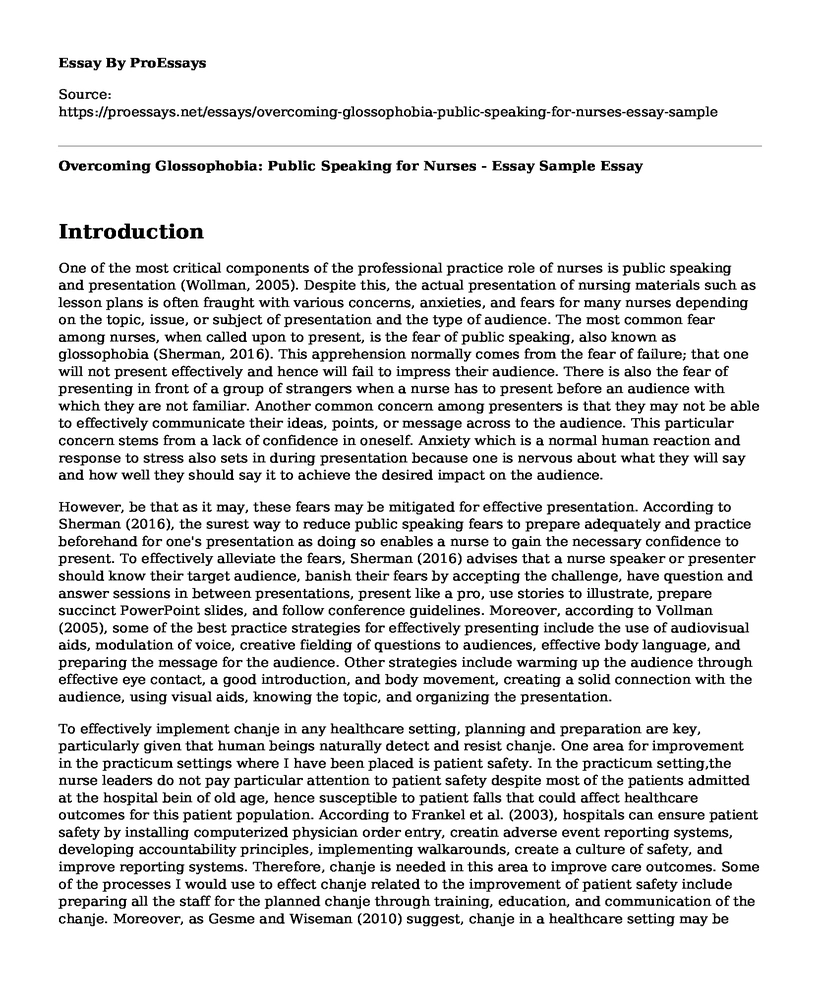Introduction
One of the most critical components of the professional practice role of nurses is public speaking and presentation (Wollman, 2005). Despite this, the actual presentation of nursing materials such as lesson plans is often fraught with various concerns, anxieties, and fears for many nurses depending on the topic, issue, or subject of presentation and the type of audience. The most common fear among nurses, when called upon to present, is the fear of public speaking, also known as glossophobia (Sherman, 2016). This apprehension normally comes from the fear of failure; that one will not present effectively and hence will fail to impress their audience. There is also the fear of presenting in front of a group of strangers when a nurse has to present before an audience with which they are not familiar. Another common concern among presenters is that they may not be able to effectively communicate their ideas, points, or message across to the audience. This particular concern stems from a lack of confidence in oneself. Anxiety which is a normal human reaction and response to stress also sets in during presentation because one is nervous about what they will say and how well they should say it to achieve the desired impact on the audience.
However, be that as it may, these fears may be mitigated for effective presentation. According to Sherman (2016), the surest way to reduce public speaking fears to prepare adequately and practice beforehand for one's presentation as doing so enables a nurse to gain the necessary confidence to present. To effectively alleviate the fears, Sherman (2016) advises that a nurse speaker or presenter should know their target audience, banish their fears by accepting the challenge, have question and answer sessions in between presentations, present like a pro, use stories to illustrate, prepare succinct PowerPoint slides, and follow conference guidelines. Moreover, according to Vollman (2005), some of the best practice strategies for effectively presenting include the use of audiovisual aids, modulation of voice, creative fielding of questions to audiences, effective body language, and preparing the message for the audience. Other strategies include warming up the audience through effective eye contact, a good introduction, and body movement, creating a solid connection with the audience, using visual aids, knowing the topic, and organizing the presentation.
To effectively implement chanje in any healthcare setting, planning and preparation are key, particularly given that human beings naturally detect and resist chanje. One area for improvement in the practicum settings where I have been placed is patient safety. In the practicum setting,the nurse leaders do not pay particular attention to patient safety despite most of the patients admitted at the hospital bein of old age, hence susceptible to patient falls that could affect healthcare outcomes for this patient population. According to Frankel et al. (2003), hospitals can ensure patient safety by installing computerized physician order entry, creatin adverse event reporting systems, developing accountability principles, implementing walkarounds, create a culture of safety, and improve reporting systems. Therefore, chanje is needed in this area to improve care outcomes. Some of the processes I would use to effect chanje related to the improvement of patient safety include preparing all the staff for the planned chanje through training, education, and communication of the chanje. Moreover, as Gesme and Wiseman (2010) suggest, chanje in a healthcare setting may be implemented by establishing a shared vision and direction for the chanje, providing effective, supportive leadership, creating an organizational culture that supports chanje, enhancing people's readiness for chanje, and handling resisters. Thus, in this context, I would affect the chanje of patient safety improvement by communicating the chanje across the organization, fostering a team culture, identifying and empowering champions of the chanje, and providing feedback and positive reinforcement.
References
Frankel, A., Gandhi, T.K., & Bates, D.W. (2003). Improving patient safety across a largeintegrated health care delivery system. International Journal for Quality in Healthcare, 15(1), 31-40
Gesme, D., & Wiseman, M. (2010). How to implement chanje in practice. Journal of Oncology Practice, 6(5), 257-259. DOI: 10.1200/JOP.000089
Sherman, R.O. (2016, April 7).Gaining confidence in public speaking. American Nurse.https://www.myamericannurse.com/gaining-confidence-public-speaking/
Wollman, K. (2005). CE: Enhancin presentation skills for the advanced practice nurse: Strategiesfor success. AACN Advanced Critical Care, 15 (1), 67-77
Cite this page
Overcoming Glossophobia: Public Speaking for Nurses - Essay Sample. (2023, Jun 08). Retrieved from https://proessays.net/essays/overcoming-glossophobia-public-speaking-for-nurses-essay-sample
If you are the original author of this essay and no longer wish to have it published on the ProEssays website, please click below to request its removal:
- Causes and Treatment of Epilepsy
- Health Promotions among Diverse Populations - Essay Sample
- Effects of Breast Cancer on Patient and Their Families Paper Example
- Impact of Alzheimer Disease on Family Patients Paper Example
- Essay Sample on Nursing Curriculum
- Essay Sample on Emergency Departments: A National Stress & Concern
- Asthma: Swelling, Wheezing, & Shortness of Breath - Essay Sample







